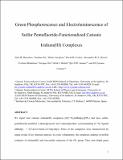Files in this item
Green phosphorescence and electroluminescence of sulfur pentafluoride-functionalized cationic iridium(III) complexes
Item metadata
| dc.contributor.author | Shavaleev, Nail Malikovich | |
| dc.contributor.author | Xie, Guohua | |
| dc.contributor.author | Varghese, Shinto | |
| dc.contributor.author | Cordes, David Bradford | |
| dc.contributor.author | Slawin, Alexandra Martha Zoya | |
| dc.contributor.author | Momblona, Cristina | |
| dc.contributor.author | Ortí, Enrique | |
| dc.contributor.author | Bolink, Henk J. | |
| dc.contributor.author | Samuel, Ifor David William | |
| dc.contributor.author | Zysman-Colman, Eli | |
| dc.date.accessioned | 2016-06-02T23:32:40Z | |
| dc.date.available | 2016-06-02T23:32:40Z | |
| dc.date.issued | 2015-06-15 | |
| dc.identifier | 189144063 | |
| dc.identifier | c6bb9ed8-c118-48c2-82b1-41f72bbb3868 | |
| dc.identifier | 84935910328 | |
| dc.identifier | 000356467100032 | |
| dc.identifier.citation | Shavaleev , N M , Xie , G , Varghese , S , Cordes , D B , Slawin , A M Z , Momblona , C , Ortí , E , Bolink , H J , Samuel , I D W & Zysman-Colman , E 2015 , ' Green phosphorescence and electroluminescence of sulfur pentafluoride-functionalized cationic iridium(III) complexes ' , Inorganic Chemistry , vol. 54 , no. 12 , pp. 5907–5914 . https://doi.org/10.1021/acs.inorgchem.5b00717 | en |
| dc.identifier.issn | 0020-1669 | |
| dc.identifier.other | ORCID: /0000-0002-5366-9168/work/28023999 | |
| dc.identifier.other | ORCID: /0000-0001-7183-6022/work/56639041 | |
| dc.identifier.other | ORCID: /0000-0002-9527-6418/work/56861332 | |
| dc.identifier.uri | https://hdl.handle.net/10023/8921 | |
| dc.description | EZ-C acknowledges the University of St Andrews for financial support. | en |
| dc.description.abstract | We report four cationic iridium(III) complexes [Ir(C^N)2(dtBubpy)](PF6) that have sulfurpentafluoride-modified 1-phenylpyrazole and 2-phenylpyridine cyclometalating (C^N) ligands (dtBubpy = 4,4'-di-tert-butyl-2,2'-bipyridyl). Three of the complexes were characterized by single-crystal X-ray structure analysis. In cyclic voltammetry, the complexes undergo reversible oxidation of iridium(III) and irreversible reduction of the SF5 group. They emit bright green phosphorescence in acetonitrile solution and in thin films at room temperature, with emission maxima between 482–519 nm and photoluminescence quantum yields of up to 79%. The electron-withdrawing sulfur pentafluoride group on the cyclometalating ligands increases the oxidation potential and the redox gap and blue-shifts the phosphorescence of the iridium complexes more than do the commonly-employed fluoro and trifluoromethyl groups. The irreversible reduction of the SF5 group may be a problem in organic electronics; for example, the complexes do not exhibit electroluminescence in light-emitting electrochemical cells (LEECs). Nevertheless, the complexes exhibit green to yellow-green electroluminescence in doped multilayer organic light-emitting diodes (OLEDs) with emission maxima ranging from 501–520 nm and with an external quantum efficiency (EQE) of up to 1.7% in solution-processed devices. | |
| dc.format.extent | 2342058 | |
| dc.language.iso | eng | |
| dc.relation.ispartof | Inorganic Chemistry | en |
| dc.subject | QD Chemistry | en |
| dc.subject | DAS | en |
| dc.subject.lcc | QD | en |
| dc.title | Green phosphorescence and electroluminescence of sulfur pentafluoride-functionalized cationic iridium(III) complexes | en |
| dc.type | Journal article | en |
| dc.contributor.sponsor | EPSRC | en |
| dc.contributor.sponsor | EPSRC | en |
| dc.contributor.institution | University of St Andrews. School of Physics and Astronomy | en |
| dc.contributor.institution | University of St Andrews. School of Chemistry | en |
| dc.contributor.institution | University of St Andrews. EaSTCHEM | en |
| dc.contributor.institution | University of St Andrews. Condensed Matter Physics | en |
| dc.identifier.doi | 10.1021/acs.inorgchem.5b00717 | |
| dc.description.status | Peer reviewed | en |
| dc.date.embargoedUntil | 2016-06-03 | |
| dc.identifier.url | http://pubs.acs.org/doi/suppl/10.1021/acs.inorgchem.5b00717 | en |
| dc.identifier.grantnumber | EP/K031252/1 | en |
| dc.identifier.grantnumber | EP/K039210/1 | en |
This item appears in the following Collection(s)
Items in the St Andrews Research Repository are protected by copyright, with all rights reserved, unless otherwise indicated.

